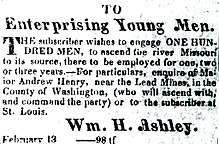William Henry Ashley
William Henry Ashley (c. 1778 – March 26, 1838) was an American miner, land speculator, manufacturer, territorial militia officer, politician, frontiersman, trapper, fur trader, entrepreneur, and hunter. Ashley was best known for being the co-owner with Andrew Henry of the highly successful Rocky Mountain Fur Incorporated, otherwise known as "Ashley's Hundred" for the famous mountain men working for the firm from 1822–1834.
William Henry Ashley | |
|---|---|
| Born | c. 1778 |
| Died | March 26, 1838 (aged 59–60) |
| Nationality | American |
| Other names | William Ashley, William H. Ashley |
| Occupation | miner, land speculator, manufacturer, territorial militia officer, politician, congressman, frontiersman, trapper, fur trader, entrepreneur, hunter |
| Known for | Being the co-owner with Andrew Henry of the highly successful Rocky Mountain Fur Company, otherwise known as "Ashley's Hundred" for the famous mountain men working for their firm from 1822-1834 |
Early life and ventures
Although born a native of Powhatan County, Virginia, William Ashley had already moved to Ste. Genevieve, in what was then a part of the Louisiana Territory, when it was purchased by the United States from France in 1803. On a portion of this land, later known as Missouri, Ashley made his home for most of his adult life. Ashley moved to St. Louis, around 1808, and became a Brigadier General in the Missouri Militia, during the War of 1812. Before the war, he did some real estate speculation and earned a small fortune manufacturing gunpowder from a lode of saltpeter mined in a cave, near the headwaters of the Current River in Missouri. When Missouri was admitted to the Union, William Henry Ashley was elected its first Lieutenant Governor, serving, from 1820–1824, under Governor Alexander McNair. Ashley ran for governor of Missouri, in the August 1824 election, but was defeated.
Entry into the fur trade

In the early 1820s, William Henry Ashley and Andrew Henry—a bullet maker he met through his gunpowder business—posted famous advertisements in St. Louis newspapers seeking one hundred "enterprising young men . . . to ascend the river Missouri to its source, there to be employed for one, two, or three years." The men who responded to this call became known as "Ashley's Hundred." Between 1822 and 1825, Ashley and Henry's Rocky Mountain Fur Company, did several large scale fur trapping expeditions in the mountain west. Ashley's men are officially credited with the American discovery of South Pass in the winter of 1824. Ashley devised the rendezvous system in which trappers, Indians and traders would meet annually in a predetermined location to exchange furs, goods and money. His innovations in the fur trade earned Ashley a great deal of money and recognition, and helped open the western part of the continent to American expansion.
In 1825, he led an expedition into the Salt Lake Valley. South of the Great Salt Lake, he discovered Utah Lake, which he named Lake Ashley.[1] He established Fort Ashley on the banks to trade with the Indians. Over the next three years, according to 19th century historian Frances Fuller Victor, the fort "collected over one-hundred-and-eighty thousand dollars' worth of furs".[2] In late 1824 he explored present-day northern Colorado, ascending the South Platte River to the base of the Front Range, then ascending the Cache la Poudre River to the Laramie Plains and onward to the Green River.
On June 2, 1823, General Ashley was beaten by Arikara Indians at their villages near the Grand River. Ashley reported twelve men killed and eleven wounded, of whom two died.[3]
Later political career and death
In 1826, Ashley sold the fur trading company to a group including Jedediah Smith, but continued supplying the company and brokering their furs. Upon the death of Spencer Darwin Pettis in August 1831, he was elected to finish out Pettis's term in the United States House of Representatives. As a member of the Jacksonian Party, Ashley won election to the seat in 1832, and re-election in 1834. In 1836, he declined to run for a fourth term in Congress, instead running unsuccessfully for Governor of Missouri. Many attribute his defeat to his increasingly pro-business stance in Congress, which alienated the rural Jacksonians. After the loss, he went back to making money on real estate, but his health declined rapidly. On March 26, 1838, William Henry Ashley died of pneumonia, at the age of 59. Ashley was buried atop a Native American burial mound in Lamine Township, Cooper County, Missouri, overlooking the juncture of the Lamine River and the Missouri River.
William H. Ashley is the namesake of the small community of Ashley, Missouri.[4] Also Ashley Falls[5] and Ashley Creek in northeast Utah, and the Ashley National Forest.[6]
Further reading
William H. Ashley. The Journal of William H. Ashley: The Rocky Mountain Papers (1825). ISBN 1546376666.
References
- Whitney, Orson Ferguson (1892). History of Utah. G. Q. Cannon. p. 293.
- Victor, Francis Fuller. . R.W. Bliss. p. 33.
- "Notes on General Ashley, the Overland Trail, and South Pass" Proceedings of the American Antiquarian Society 54(2): 161-312. 1944
- Eaton, David Wolfe (1917). How Missouri Counties, Towns and Streams Were Named. The State Historical Society of Missouri. pp. 341.
- http://www.flaminggorgecountry.com/media/uploads/files/The-Dreaded-Ashley-Falls.pdf
- http://www.fs.usda.gov/Internet/FSE_DOCUMENTS/stelprdb5276871.pdf#page=2
- Morgan, Dale., The West of William H. Ashley, (Denver, 1964) ISBN
External links
- United States Congress. "William Henry Ashley (id: A000315)". Biographical Directory of the United States Congress.
- "Ashley, William Henry" The Columbia Electronic Encyclopedia, 6th ed.
- American National Biography - Ashley, William Henry
- William Ashley - National Park Service
- William H. Ashley's 1825 Rocky Mountain Papers
| Political offices | ||
|---|---|---|
| Preceded by Position established |
Lieutenant Governor of Missouri 1820–1824 |
Succeeded by Benjamin Harrison Reeves |
| U.S. House of Representatives | ||
| Preceded by Spencer D. Pettis |
Member of the U.S. House of Representatives from Missouri's at-large congressional district 1831–1837 |
Succeeded by John Miller |
